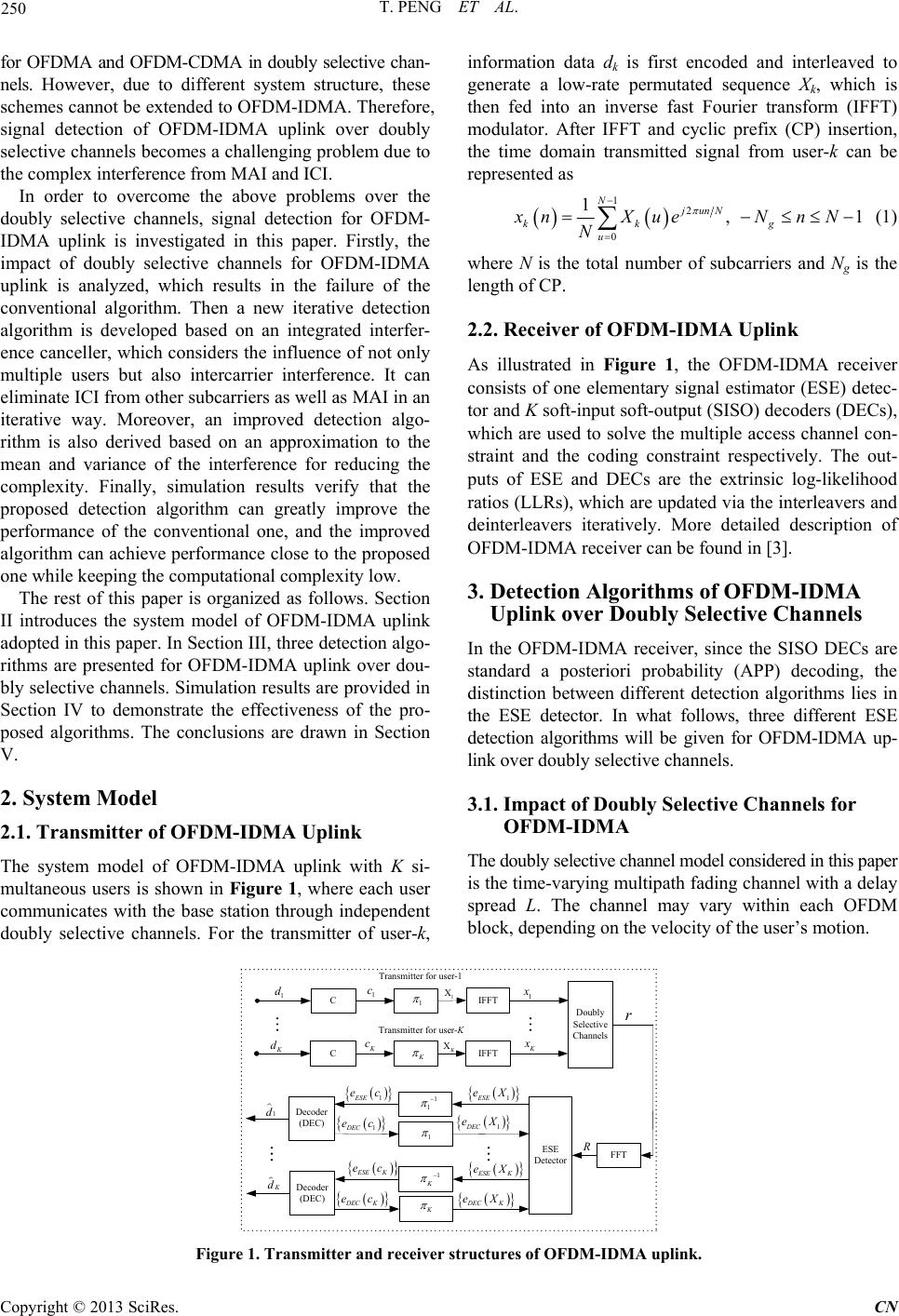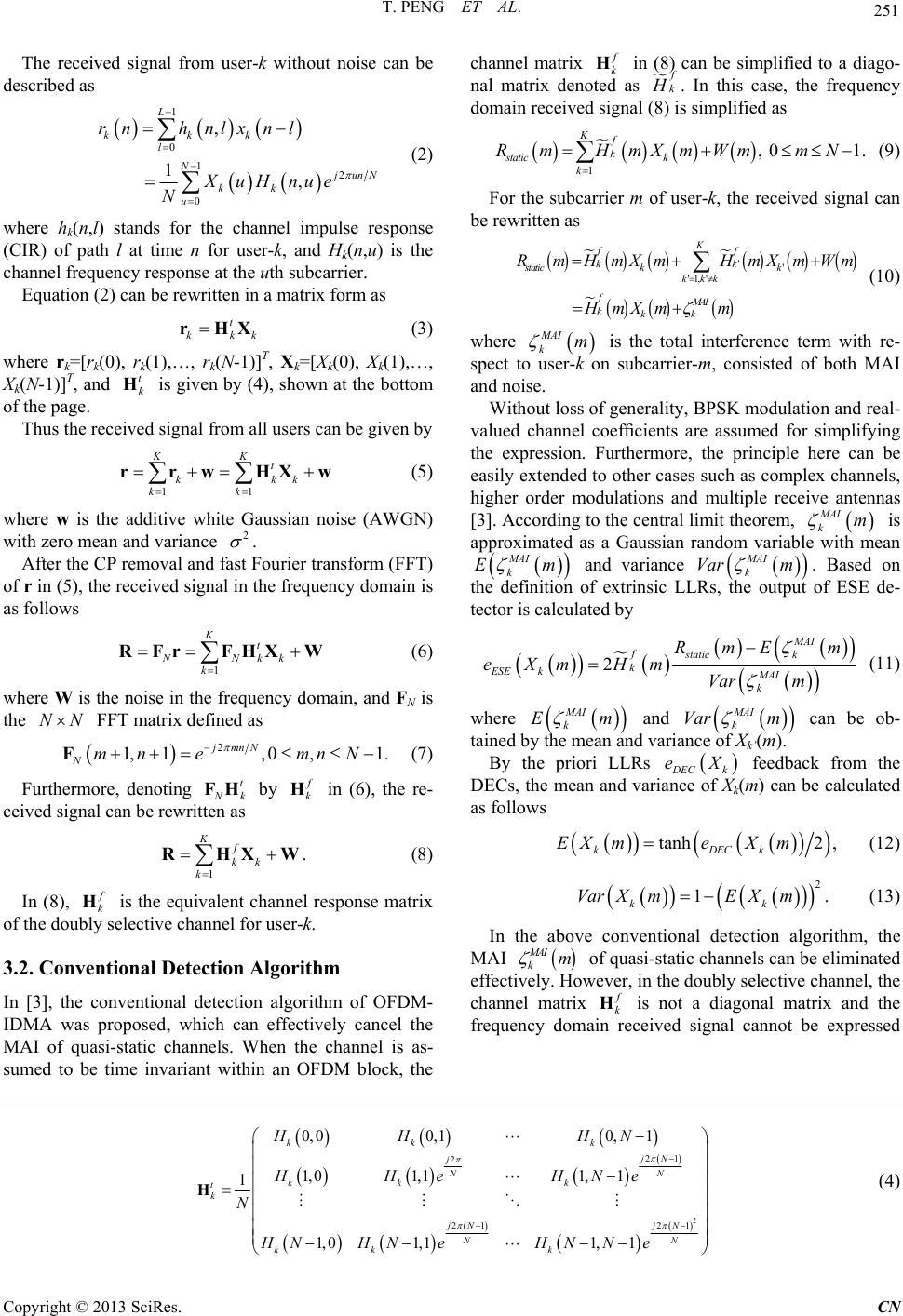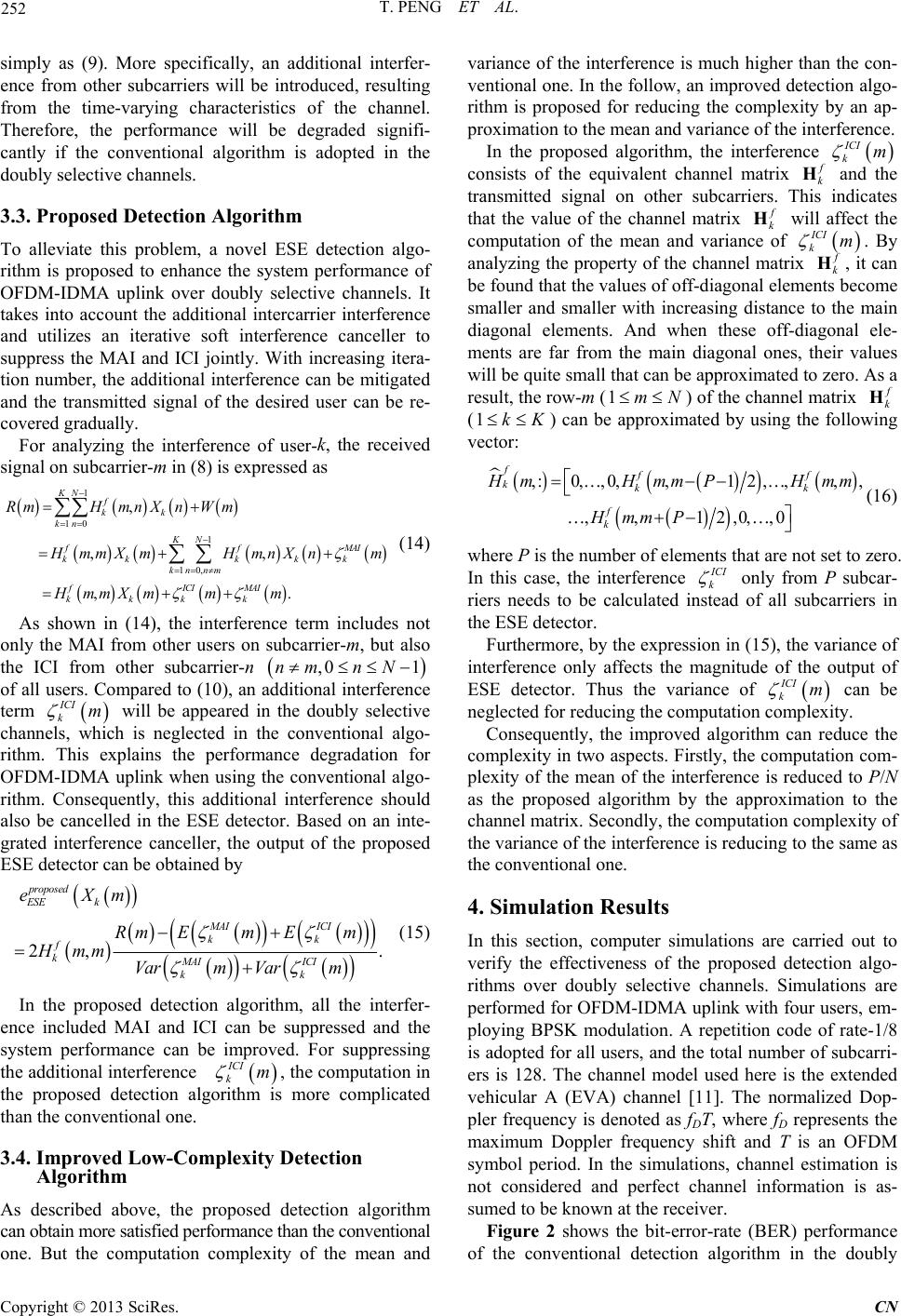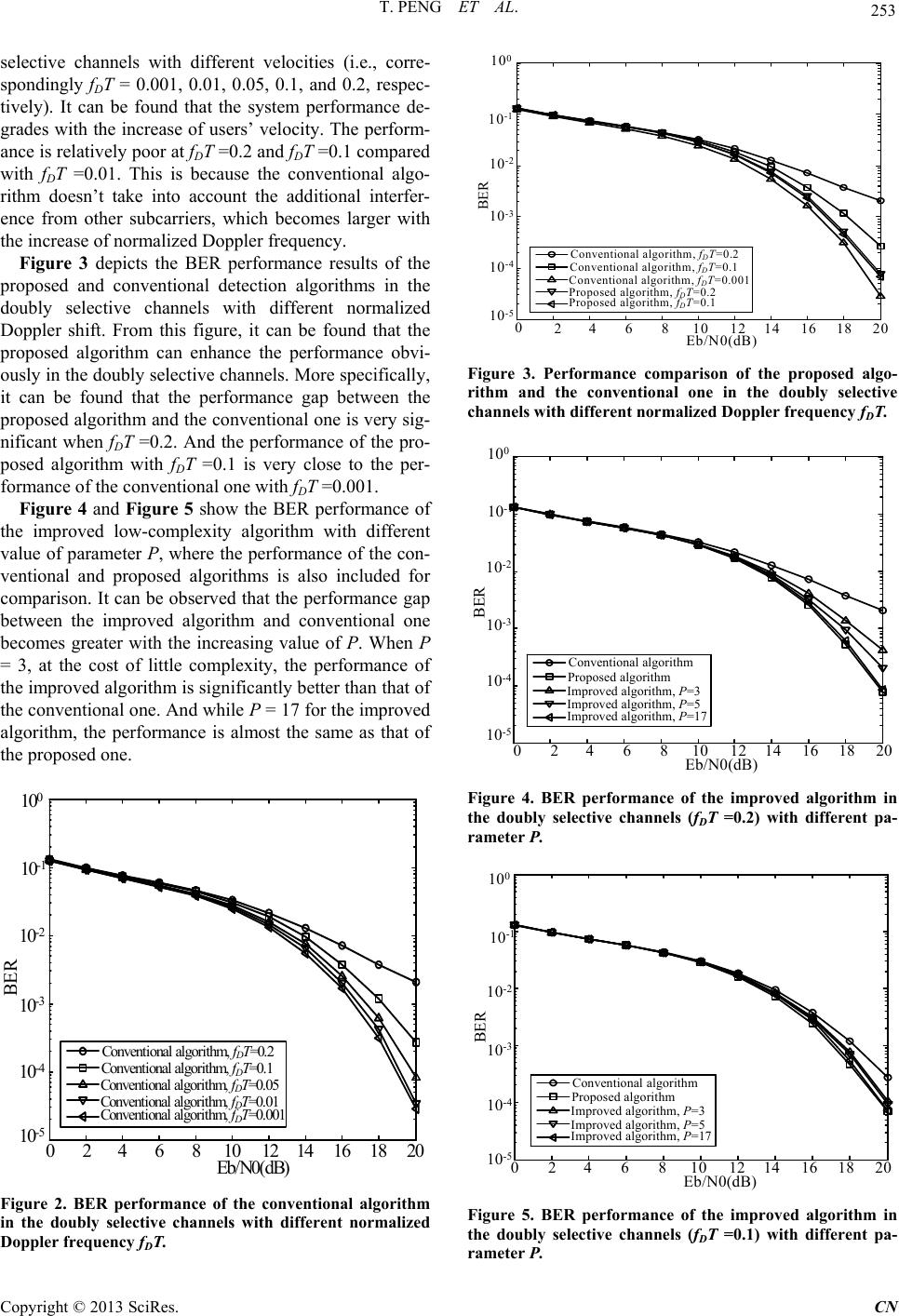 Communications and Network, 2013, 5, 249-254 http://dx.doi.org/10.4236/cn.2013.53B2046 Published Online September 2013 (http://www.scirp.org/journal/cn) Signal Detection for OFDM-IDMA Uplink over Doubly Selective Channels* Tao Peng1, Yue Xiao1, Shaoqian Li1, Huaqi an g S hu2, Eric Pierre Simon2 1Nation Key Lab of Sci. and Techno. On Commun. University of Electronic Sci. and Techno. of China, Chengdu, China 2IEMN Lab, TELICE Group, University of Lille, Lille, France Received June, 2013 ABSTRACT Orthogonal frequency division multiplexing-interleave division multiple access (OFDM-IDMA) systems may suffer from serious inter-carrier interference (ICI) in time-and frequency-selective (doubly selective) channels. In such case, the conventional OFDM-IDMA detection algorithm for quasi-static channels will result in significantly performance degradation. In this paper, signal detection is investigated for OFDM-IDMA uplink over doubly selective channels. Firstly, the impact of time-varying channels for OFDM-IDMA uplink is analyzed, which leads to the failure of the con- ventional algorithm. Secondly, a novel iterative detection algorithm is developed based on an integrated interference canceller, which can iteratively estimate and mitigate the ICI as well as multiple access interference (MAI) simultane- ously. In addition, an improved detection algorithm is derived for reducing the complexity using an approximation to the mean and variance of the in terference. Simulation results indicate that the proposed algorithm can significan tly en- hance the system performance to the conventional case, and the improved algorithm can strike a balance between per- formance and complexity. Keywords: Interleave Division Multiple Access (IDMA); Orthogonal Frequency Division Multiplexing (OFDM); Doubly Selective Channel 1. Introduction As a kind of non-orthogonal multiple access scheme, interleave division multiple access (IDMA) was devel- oped by Ping et al.[1,2], in which random interleavers are employed as the only means for user separation. In gen- eral, IDMA outperforms conventional code division mul- tiple access (CDMA) in terms of power and bandwidth efficiency. The key innovation of IDMA is the introduc- tion of low-rate channel coding, chip-level interleaving and low-complexity multiuser detection. On the other hand, orthogonal frequency division multiplexing (OFDM) is an attractive transmission technique for future wireless communication due to its high spectral efficiency and excellent robustness to frequency-selective fading. Based on the combination of IDMA and OFDM, OFDM-IDMA was presented for achieving the advantages of both sys- tems [3]. In OFDM-IDMA systems, inter-symbol inter- ference (ISI) can be mitigated by OFDM and multiple access interference (MAI) can be suppressed by IDMA. Moreover, OFDM-IDMA can achieve more throughput and reliability than conventional OFDM-CDMA and orthogonal frequency-division multiple access (OFDMA) [3-5]. In [3], an iterative multi-user detection scheme is de- rived for OFDM-IDMA, where the complexity of each user is independent of the channel length and number of users. However, it assumes that the frequency-selective channels are time invariant (quasi-static) within an OFDM block. In practice, high speed movement of mobile ter- minals will cause Doppler spread and result in time- varying multipath fading channels [6,7]. In this case, the channels will be time and frequency-selective (doubly selective), in which the length of an OFDM block is longer than th e coherent time. As a result, the time varia- tion of doubly selective channels will destroy the or- thogonal property among subcarriers and induce in- ter-carrier interference (ICI), which complicates the data detection in the receiver. *This work was supported by the Foundation Project of National Key Laboratory of Science and Technology on Communications under Grant 9140C020404120C0201, National High-Tech R&D Program of China ("863" Project under Grant number 2011AA01A105), Na- tional Grand Special Science and Technology Project of China under Grant No. 2010ZX03006-002-02, and the Fundamental Research Funds for the Central Universities. Due to this additional interference from other subcar- riers, the conventional OFDM-IDMA detection algo- rithm [3] will degrade the system performance severely in the doubly selective channels. In [8-10], several inter- carrier interference cancellation schemes were proposed C opyright © 2013 SciRes. CN  T. PENG ET AL. 250 for OFDMA and OFDM-CDMA in doubly selective chan- nels. However, due to different system structure, these schemes cannot be extended to OFDM-IDMA. Therefore, signal detection of OFDM-IDMA uplink over doubly selective channels becomes a challenging problem due to the complex interference from MAI and ICI. In order to overcome the above problems over the doubly selective channels, signal detection for OFDM- IDMA uplink is investigated in this paper. Firstly, the impact of doubly selective channels for OFDM-IDMA uplink is analyzed, which results in the failure of the conventional algorithm. Then a new iterative detection algorithm is developed based on an integrated interfer- ence canceller, which considers the influence of not only multiple users but also intercarrier interference. It can eliminate ICI from other subcarriers as well as MAI in an iterative way. Moreover, an improved detection algo- rithm is also derived based on an approximation to the mean and variance of the interference for reducing the complexity. Finally, simulation results verify that the proposed detection algorithm can greatly improve the performance of the conventional one, and the improved algorithm can achieve performance close to the proposed one while keeping the computational complexity low. The rest of this paper is organized as follows. Section II introduces the system model of OFDM-IDMA uplink adopted in this paper. In Section III, three detection algo- rithms are presented for OFDM-IDMA uplink over dou- bly selective channels. Simulation results are provided in Section IV to demonstrate the effectiveness of the pro- posed algorithms. The conclusions are drawn in Section V. 2. System Model 2.1. Transmitter of OFDM-IDMA Uplink The system model of OFDM-IDMA uplink with K si- multaneous users is shown in Figure 1, where each user communicates with the base station through independent doubly selective channels. For the transmitter of user-k, information data dk is first encoded and interleaved to generate a low-rate permutated sequence Xk, which is then fed into an inverse fast Fourier transform (IFFT) modulator. After IFFT and cyclic prefix (CP) insertion, the time domain transmitted signal from user-k can be represented as 12 0 1 1, NjunN kk ug xnXuN ne NN (1) where N is the total number of subcarriers and Ng is the length of CP. 2.2. Receiver of OFDM-IDMA Uplink As illustrated in Figure 1, the OFDM-IDMA receiver consists of one elementary signal estimator (ESE) detec- tor and K soft-input soft-output (SISO) decoders (DECs), which are used to solve the multiple access channel con- straint and the coding constraint respectively. The out- puts of ESE and DECs are the extrinsic log-likelihood ratios (LLRs), which are updated via the interleavers and deinterleavers iteratively. More detailed description of OFDM-IDMA receiver can be found in [3]. 3. Detection Algorithms of OFDM-IDMA Uplink over Doubly Selective Channels In the OFDM-IDMA receiver, since the SISO DECs are standard a posteriori probability (APP) decoding, the distinction between different detection algorithms lies in the ESE detector. In what follows, three different ESE detection algorithms will be given for OFDM-IDMA up- link over doubly selective channels. 3.1. Impact of Doubly Selective Channels for OFDM-IDMA The doubly selective channel model considered in this paper is the time-varying multipath fad ing channel with a d elay spread L. The channel may vary within each OFDM block, depending on the velocity of the user’s motion. C Decoder (DEC) Doubly Selective Channels ESE Detector Transmitter for user-1 Transmitter for user-K 1ESE eX r 1 d K d 1 d K d 1 c1 K 1DEC eX 1ESE ec 1DEC ec ESE K eX DEC K eX ESE K ec DEC K ec CK c 1 1 1 K K 1 K IFFT IFFT FFT 1 X XK 1 Decoder (DEC) Figure 1. Transmitter and receiver structures of OFDM-IDMA uplink. Copyright © 2013 SciRes. CN  T. PENG ET AL. 251 The received signal from user-k without noise can be described as 1 0 12 0 , 1, L kkk l N un N kk u rn hnlxnl XuHnue N (2) where hk(n,l) stands for the channel impulse response (CIR) of path l at time n for user-k, and Hk(n,u) is the channel frequency response at the uth subcarrier. Equation (2) can be rewritten in a matrix form as t kk rHX k w (3) where rk=[rk(0), rk(1),…, rk(N-1)]T, Xk=[Xk(0), Xk(1),…, Xk(N-1)]T, and is given by (4), shown at the bottom of the page. t k H Thus the received signal from all users can be given by 11 KK t kkk kk rrwHX (5) where w is the additive white Gaussian noise (AWGN) with zero mean and variance 2 . After the CP removal and fast Fourier transform (FFT) of r in (5), the received signal in the frequency domain is as follows 1 Kt NNkk k RFrFHX W (6) where W is the noise in the frequency domain, and FN is the FFT matrix defined as NN 2 1,1, 0,1. jmnN Nmn emnN F (7) Furthermore, denoting t k FH by k H in (6), the re- ceived signal can be rewritten as 1. Kf kk k RHXW (8) In (8), k H is the equivalent channel response matrix of the doubly selective channel for user-k. 3.2. Conventional Detection Algorithm In [3], the conventional detection algorithm of OFDM- IDMA was proposed, which can effectively cancel the MAI of quasi-static channels. When the channel is as- sumed to be time invariant within an OFDM block, the channel matrix k H in (8) can be simplified to a diago- nal matrix denoted as k . In this case, the frequency domain received signal (8) is simplified as 1,0 1 Kf k static k k Rm HmXmWmmN (9) For the subcarrier m of user-k, the received signal can be rewritten as '' '1,' K ff kk static kk kkk fMAI kkk RmHmXm HmXmWm HmXm m (10) where MAI km is the total interference term with re- spect to user-k on subcarrier-m, consisted of both MAI and noise. Without loss of generality, BPSK modulation and real- valued channel coefficients are assumed for simplifying the expression. Furthermore, the principle here can be easily extended to other cases such as complex channels, higher order modulations and multiple receive antennas [3]. According to the central limit theorem, MAI km is approximated as a Gaussian random variable with mean MAI k Em and variance . Based on the definition of extrinsic LLRs, the output of ESE de- tector is calculated by MAI k Var m 2 MAI fstatic k k ESE kMAI k RmEm eXmHmVar m (11) where MAI k Em and can be ob- tained by the mean and variance of Xk’(m). MAI k Var m By the priori LLRs EC k eX feedback from the DECs, the mean and variance of Xk(m) can be calculated as follows tanh2 , kDECk EX meX m (12) 2 1. kk VarXmEX m (13) In the above conventional detection algorithm, the MAI MAI km of quasi-static channels can be eliminated effectively. However, in the doubly selective channel, the channel matrix k H is not a diagonal matrix and the frequency domain received signal cannot be expressed 2 21 2 21 21 0,10, 1 1, 01,11,1 1 1, 01, 0,0 11,1 kk k jN j N kk k t k jN jN NN kk k HHN HHe HNe N HNHN eH H NNe H N (4) Copyright © 2013 SciRes. CN  T. PENG ET AL. 252 simply as (9). More specifically, an additional interfer- ence from other subcarriers will be introduced, resulting from the time-varying characteristics of the channel. Therefore, the performance will be degraded signifi- cantly if the conventional algorithm is adopted in the doubly selective chan nels. 3.3. Proposed Detection Algorithm To alleviate this problem, a novel ESE detection algo- rithm is proposed to enhance the system performance of OFDM-IDMA uplink over doubly selective channels. It takes into account the additional intercarrier interference and utilizes an iterative soft interference canceller to suppress the MAI and ICI jointly. With increasing itera- tion number, the additional interference can be mitigated and the transmitted signal of the desired user can be re- covered gradually. For analyzing the interference of user-k, the received signal on s ubcarrier- m in (8) is expressed as 1 10 1 10, , ,, ,. KN f kk kn KN ff kk kkk knnm fICIMAI kkkk RmHmnX nWm HmmXmHmnXn m HmmXmmm MAI (14) As shown in (14), the interference term includes not only the MAI from other users on subcarrier-m, but also the ICI from other subcarrier-n of all users. Compared to (10), an additional in terference term will be appeared in the doubly selective channels, which is neglected in the conventional algo- rithm. This explains the performance degradation for OFDM-IDMA uplink when using the conventional algo- rithm. Consequently, this additional interference should also be cancelled in the ESE detector. Based on an inte- grated interference canceller, the output of the proposed ESE detector can be obt a i ned by ,0 1nm nN ICI km 2, proposed ESE k MAI ICI kk f kMAI ICI kk eXm Rm Em Em Hmm VarmVarm . (15) In the proposed detection algorithm, all the interfer- ence included MAI and ICI can be suppressed and the system performance can be improved. For suppressing the additional in terference , the computation in the proposed detection algorithm is more complicated than the conventional one. ICI km 3.4. Improved Low-Complexity Detection Algorithm As described above, the proposed detection algorithm can obtain more satisfied performance than the conventional one. But the computation complexity of the mean and variance of the interference is much higher than the con- ventional one. In the follow, an improved detection algo- rithm is proposed for reducing the complexity by an ap- proximation to the mean and variance of the interference. In the proposed algorithm, the interference ICI km consists of the equivalent channel matrix k H and the transmitted signal on other subcarriers. This indicates that the value of the channel matrix k H will affect the computation of the mean and variance of Im IC k . By analyzing the property of the chann el matrix k H, it can be found that the values of off-diagonal elements become smaller and smaller with increasing distance to the main diagonal elements. And when these off-diagonal ele- ments are far from the main diagonal ones, their values will be quite small that can be approximated to zero. As a result, the row-m (1mN ) of the channel matrix k H (1kK ) can be approximated by using the following vector: ,0,,12,,, ,120 fff kkk f k HmHmmP Hmm HmmP (16) where P is the number of elements that are not set to zero. In this case, the interference CI k only from P subcar- riers needs to be calculated instead of all subcarriers in the ESE detector. Furthermore, by the expression in (15), the variance of interference only affects the magnitude of the output of ESE detector. Thus the variance of can be neglected for reducing the computation complexity. ICI km Consequently, the improved algorithm can reduce the complexity in two aspects. Firstly, the computation com- plexity of the mean of the interference is reduced to P/N as the proposed algorithm by the approximation to the channel matrix. Secondly, the computatio n complexity of the variance o f th e in terferen ce is reducing to the same as the conventional one. 4. Simulation Results In this section, computer simulations are carried out to verify the effectiveness of the proposed detection algo- rithms over doubly selective channels. Simulations are performed for OFDM-IDMA uplink with four users, em- ploying BPSK modulation. A repetition code of rate-1/8 is adopted for all users, and the total number of subcarri- ers is 128. The channel model used here is the extended vehicular A (EVA) channel [11]. The normalized Dop- pler frequency is denoted as fDT, where fD represents the maximum Doppler frequency shift and T is an OFDM symbol period. In the simulations, channel estimation is not considered and perfect channel information is as- sumed to be known at the receiver. Figure 2 shows the bit-error-rate (BER) performance of the conventional detection algorithm in the doubly Copyright © 2013 SciRes. CN  T. PENG ET AL. 253 selective channels with different velocities (i.e., corre- spondingly fDT = 0.001, 0.01, 0.05, 0.1, and 0.2, respec- tively). It can be found that the system performance de- grades with the increase of users’ velocity. The perform- ance is relatively poor at fDT =0.2 and fDT =0.1 compared with fDT =0.01. This is because the conventional algo- rithm doesn’t take into account the additional interfer- ence from other subcarriers, which becomes larger with the increase of normalized Doppler frequency. Figure 3 depicts the BER performance results of the proposed and conventional detection algorithms in the doubly selective channels with different normalized Doppler shift. From this figure, it can be found that the proposed algorithm can enhance the performance obvi- ously in the doubly selective channels. More specifically, it can be found that the performance gap between the proposed algo rithm and the convention al one is very sig- nificant when fDT =0.2. And the performance of the pro- posed algorithm with fDT =0.1 is very close to the per- formance of the conventional one with fDT =0.001. Figure 4 and Figure 5 show the BER performance of the improved low-complexity algorithm with different value of parameter P, where the performance of the con- ventional and proposed algorithms is also included for comparison. It can be observed that the performance gap between the improved algorithm and conventional one becomes greater with the increasing value of P. When P = 3, at the cost of little complexity, the performance of the improved algorithm is sig nificantly better th an that of the conventio nal one. And while P = 17 for the improved algorithm, the performance is almost the same as that of the proposed one. 10-1 Eb/N0(dB) R 10-3 010121416 10-2 1820 Conv ention al algorithm, fDT=0. 2 100 10-4 10-5 2684 Conventional algorithm, fDT=0.1 Conventiona l algorithm, fDT=0.05 Conventiona l algorithm, fDT=0.01 Conventiona l algorithm, fDT=0. 001 Figure 2. BER performance of the conventional algorithm in the doubly selective channels with different normalized Doppler frequency fDT. 10-1 Eb/N0(dB) BER 10-3 01012 14161820 10-2 Conventional algorithm, fDT=0.2 100 10-4 10-5 2684 Conventional algorithm, fDT=0.1 Conventional algorithm, fDT=0.001 Proposed algorithm, fDT=0.2 Proposed algorithm, fDT=0.1 Figure 3. Performance comparison of the proposed algo- rithm and the conventional one in the doubly selective channels with different nor m alized Doppler frequency fDT. 10-1 Eb/N0(dB) BER 10-3 010121416 10-2 1820 Conventional algorithm 100 10-4 10-5 2684 Proposed algorithm Improv ed al go ri th m, P=3 Improv ed al go ri th m, P=5 Improv ed al go ri th m, P=17 Figure 4. BER performance of the improved algorithm in the doubly selective channels (fDT =0.2) with different pa- rameter P. 10-1 Eb/N0(dB) BER 10-3 010121416 10-2 1820 Conventional algorithm 100 10-4 10-5 2684 Proposed alg orit hm Impr oved algo ri thm , P=3 Impr oved algo ri thm , P=5 Impr oved algo ri thm , P=17 Figure 5. BER performance of the improved algorithm in the doubly selective channels (fDT =0.1) with different pa- rameter P. Copyright © 2013 SciRes. CN  T. PENG ET AL. Copyright © 2013 SciRes. CN 254 5. Conclusions In this paper, three different detection algorithms are derived for OFDM-IDMA uplink over doubly selective channels. Among all the three detection algorithms, the conventional algorithm suffers from performance loss due to neglect of the additional interference from other subcarriers, and the proposed algorithm delivers the best performance but at the cost of higher complexity. And the improved algorithm can achieve performance close to the proposed on e but with a low co mputational co mplex- ity. Consequently, it is optimal to adopt the improved lower-complexity algorithm to obtain a tradeoff between performance and complexity. REFERENCES [1] P. Li, L. H. Liu, K. Y. Wu and W. K. Leung, “A Unified Approach to Multiuser Detection and Space-time Coding with Low Comple xity and Nearly Optimal Performance,” in Proc. 40th Allerton Conference, 2002, pp. 170-179. [2] P. Li, L. H. Liu, K. Y. Wu and W. K. Leung, “Interleave Division Multiple Access,” IEEE Transactions Wireless Communications, Vol. 5, No. 4, 2006, pp. 938-947. [3] P. Li, Q. H. Guo and J. Tong, “The OFDM-IDMA Ap- proach to Wireless Communication Systems,” IEEE Wireless Communications Mag., Vol. 14, No. 3, 2007, pp. 18-24. [4] R. Zhang and L. Hanzo, “Three Design Aspects of Multi- carrier Interleave Division Multiple Access,” IEEE Transactions Vehicular Technoogy, Vol. 57, No. 6, 2008, pp. 3607-3617. doi:10.1109/TVT.2008.918724 [5] P. Hammarberg, F. Rusek and O. Edfors, “Channel Esti- mation Algorithms for OFDM-IDMA: Complexity and Performance,” IEEE Transactions Wireless Communica- tions, Vol. 11, No. 5, 2012, pp. 1722-1732. [6] Y. Li and L. J. Cimini, “Bounds on the Interchannel Inter- ference of OFDM in Time-varying Impairments,” IEEE Transactions Communications, Vol. 49, No. 3, 2001, pp. 401-404. doi:10.1109/26.911445 [7] P. Schniter, “Low-Complexity Equalization of OFDM in Doubly Selective Channels,” IEEE Transactions Com- munications, Vol. 52, No. 4, 2004, pp. 1002-1011. [8] Y. X. Peng, K. Zheng, W. Wang, Y. Kim and Y. S. Lee, “Iterative Partial-Interference-Cancellation-based Detec- tor for OFDM Systems over Doubly-Selective Rayleigh Fading Channels,” in Proc. IEEE International Symp. On Personal, Indoor and Mobile Radio Comm., 2007, pp. 1-5. [9] T. Zemen, C. F. Mecklenbrauker, J. Wehinger and R. R. Muller, “Iterative Joint Time-variant Channel Estimation and Multi-user Detection for MC-CDMA,” IEEE Trans- actions Wireless Communications, Vol. 5, No. 4, 2006, pp. 938-947. [10] S. W. Hou and C. C. Ko, “Intercarrier Interference Sup- pression for OFDMA Uplink in Time-and Fre- quency-Selective Fading Channels,” IEEE Transactions Vehicular Technoogy, Vol. 58, No. 6, 2009, pp. 2741-2754. doi:10.1109/TVT.2008.2010550 [11] 3GPP Technical Specification 36.104, 2010, “Evolved Universal Terrestrial Radio Access (E-UTRA): Base Sta- tion(BS) Radio Transmission and Reception,” Version 9.3.0, Mar. 2010.
|